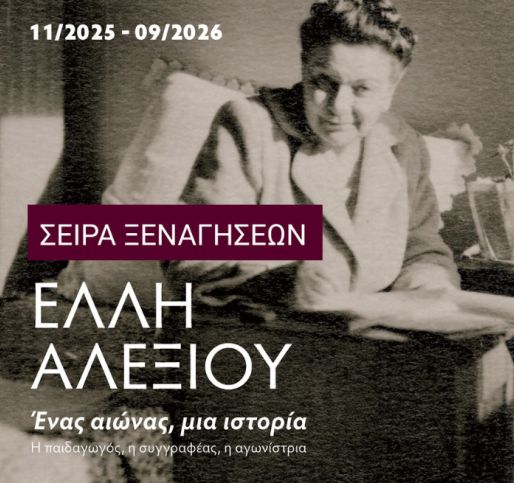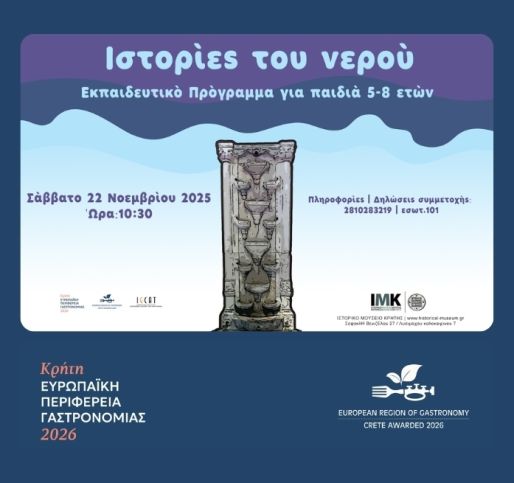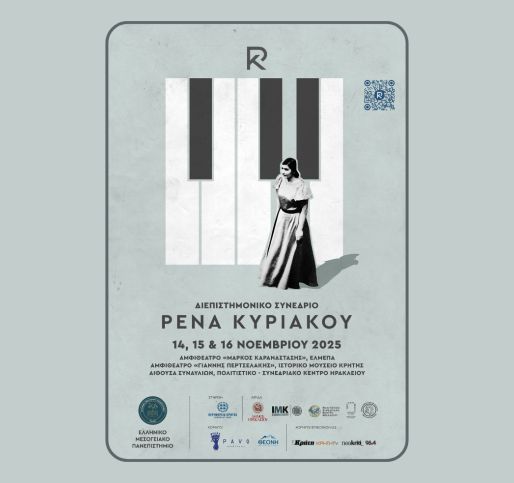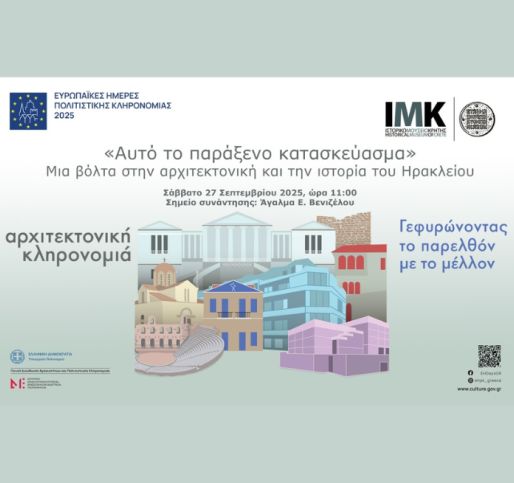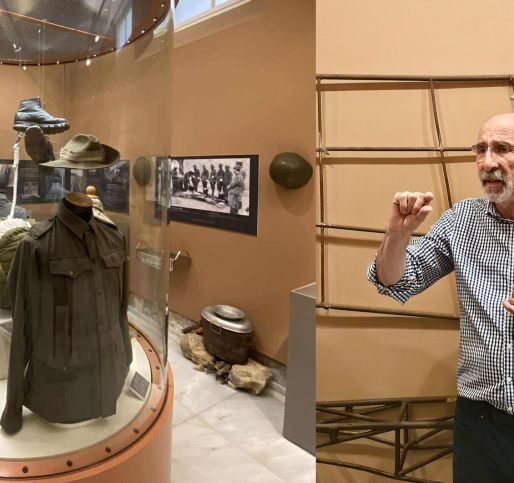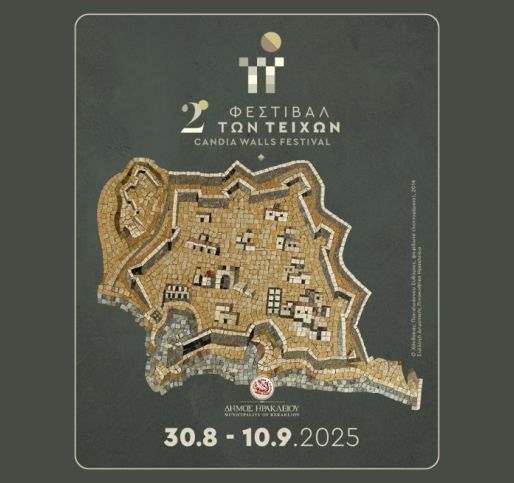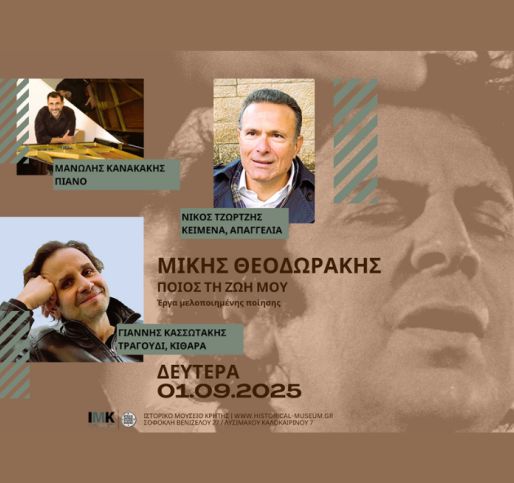The Battle of Crete, a different perspective
Scientific Meeting at the Historical Museum of Crete
SHARE IT
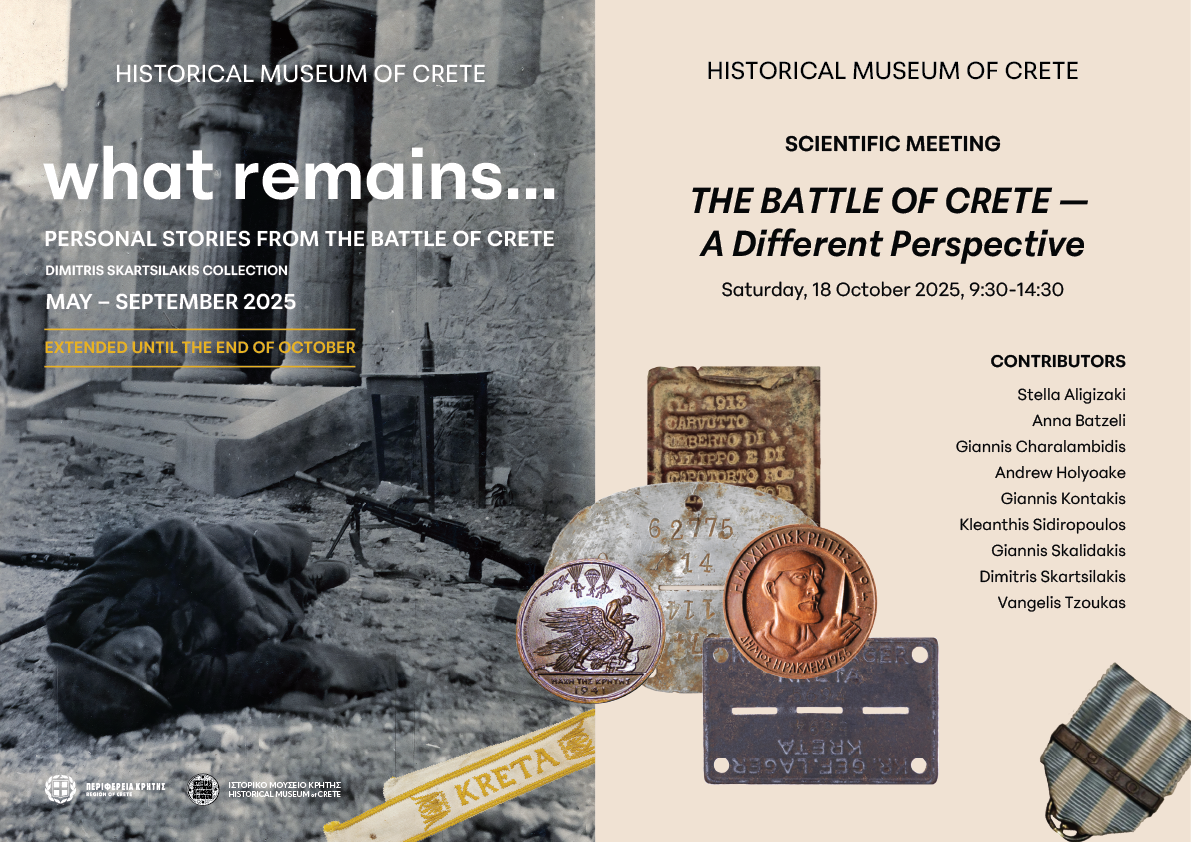
As the temporary exhibition “What remains... Personal stories from the Battle of Crete” comes to a close, the Society of Cretan Historical Studies has planned a Scientific Meeting on the same theme, to be held in the Amphitheatre of the Historical Museum of Crete on Saturday, 18 October 2025, at 9:30-14:30.
Under the title “The Battle of Crete, a different perspective”, invited speakers will talk about the era and its aftermath without directly referring to military events.
Instead, historical issues such as the unprecedented practice of harsh reprisals against the resisting inhabitants, Italian propaganda associated with the troops sent from Rhodes, the adventures of the prisoners of war in the Tymbakion camp, and the aftermath of the participation of soldiers from New Zealand in the Battle of Crete will be discussed at length.
Other papers will focus more on the post-war period, covering subjects such as the archaeology of war and contemporary collecting and museological practices, commemorative and military medals of the War, its impact on ordinary people of the time and the resulting oral narratives or memoirs, artistic depictions of the Battle and their significations, and the way in which Cretan public history has handled the events of the German invasion and the Occupation.
The meeting is, of course, open to the general public and those with an interest in history, specialists, students, and researchers.
At the conclusion of the Meeting, there will be a final guided tour of the temporary exhibition by its curators, Kleanthis Sidiropoulos and Dimitris Skartsilakis.
The programme of the Meeting and the abstracts of the presentations follow:
Scientific Meeting “The Battle of Crete, a different perspective”
Historical Museum of Crete, Saturday, 18 October 2025, 9:30-14:30
PROGRAMME
9:30-9:45 Welcome address by a member of the Board of the Society of Cretan Historical Studies and introductory comment by Κ. Sidiropoulos
1st Session | Chair: Giannis Skalidakis
9:45-10:15 Giannis Charalambidis, Political warfare and policies of repression: The Battle of Crete as a milestone in the evolution of the armed repression of civilians (in Greek)
10:15-10:45 Giannis Kontakis, The Battle of Crete through the pages of the "Messaggero di Rodi" (in Greek, online)
10:45-11:15 Vangelis Tzoukas, “And the German radio said: ‘semi-savage Cretans.’” Aspects of the daily life of the population during the Battle of Crete (in Greek)
11:15-11:45 Andrew Holyoake, Tymbakion shorts: A window through which to view the Kreta Kriegies (POWs of Crete) (in English, online)
11:45-12:00 BREAK
2nd Session | Chair: Giannis Charalambidis
12:00-12:30 Stella Aligizaki, Pictorial "testimonies" of the Battle of Crete (in Greek)
12:30-13:00 Dimitris Skartsilakis, The archaeology of war in Crete. Research and documentation (in Greek)
13:00-13:30 Anna Batzeli, "In a foreign land": Mourning the New Zealanders fallen in the Battle of Crete (in Greek)
13:30-14:00 Kleanthis Sidiropoulos, Medals and honorary distinctions for the Battle of Crete: From recognition to remembrance (in Greek)
14:00-14:30 Giannis Skalidakis, The Battle of Crete in public discourse (in Greek)
14:30-14:35 Concluding comments
The allocated presentation time includes time for questions and discussion.
The meeting will be followed by a guided tour in Greek of the temporary exhibition “What remains... Personal stories from the Battle of Crete” by its curators, Dimitris Skartsilakis and Kleanthis Sidiropoulos.
ABSTRACTS
1st Session
Giannis Charalambidis, Political warfare and policies of repression: The Battle of Crete as a milestone in the evolution of the armed repression of civilians (in Greek)
The Battle of Crete stands out not only within the context of World War II but more broadly in the history of warfare because of the mass participation of civilian populations in the fighting and the attackers’ use of disproportionate, criminal violence to suppress and terrorize the population. Placing the events in a comparative perspective, the study treats the Battle not as an isolated incident but as a distinctive and significant waypoint in the trajectory from Amritsar (1919) to My Lai (1968) - a moment in which the idea of civilians as an “enemy without uniform” and their armed repression by state military forces became increasingly normalized. By widening the analytical lens, the paper examines how political warfare and deliberate policies of repression operated during and after the battle, and how those practices influenced subsequent doctrines and practices of counter-insurgency and civilian control.
Giannis Kontakis, The Battle of Crete through the pages of the "Messaggero di Rodi" (in Greek, online)
The Battle of Crete stands out as one of the defining military operations of the Second World War. Its outcome brought Greece entirely under Axis control, following the Italian invasion of October 1940 and the German assault of April 1941. Although Italian forces were stationed in the nearby Dodecanese islands under Italian occupation, their involvement in the capture of Crete was limited and largely in support of the German army. Even so, the events on the battlefield and the actions of the small Italian expeditionary force that landed on the island on 27 May 1941 were given extensive coverage in the Messaggero di Rodi.
This newspaper, founded in 1912, served as both the voice of the Italian administration and a vehicle of propaganda in the Dodecanese, addressing Italians as well as the local population. For nine consecutive days, its pages were filled with articles, photographs, maps, and reports from the fighting, offering a glimpse of the battle through the eyes of Italian soldiers and revealing the workings of the Italian propaganda machine.
This presentation explores that experience as it was portrayed in the Messaggero di Rodi, set against original archival and photographic material, alongside the testimonies of Italian soldiers.
Vangelis Tzoukas, “And the German radio said: ‘semi-savage Cretans.’” Aspects of the daily life of the population during the Battle of Crete (in Greek)
This presentation explores the lived experience of the Cretan population during the Battle of Crete (May 1941), as conveyed through oral testimonies, most of them published. These accounts vividly capture the ambiguities of people’s attitudes toward the Germans, the Allies, and soldiers from other parts of Greece, as well as the immense pressures generated by the battle itself and the survival strategies it demanded.
They also highlight the ways in which ordinary people - the “hidden” protagonists of history - processed their experiences in the extreme conditions of a total war. In doing so, the testimonies offer a different lens through which to view events that belong to both national and transnational narratives. At the same time, they reveal the limitations of oral accounts: possible self-censorship, silences, and omissions, especially regarding sensitive aspects of the battle such as the involvement of armed civilians in clashes with German paratroopers and the psychological strain borne by all those involved.
Finally, attention is given to the diverse backgrounds of the narrators, which bring to light differences of gender, social origin, and local identity, enriching our understanding of how the battle was lived and remembered.
Andrew Holyoake, Tymbakion shorts: A window through which to view the Kreta Kriegies (POWs of Crete) (in English, online)
The common British and Dominion prisoner of war narrative in the aftermath of the Battle of Crete is of a large, disordered, unhygienic holding camp at Galatas, followed by rapid transport off Crete to permanent camps on mainland Europe. Alternative narratives talk of the escapers/evaders, whose tales excite the imagination and are relatively well documented. This presentation, told through the lens of a pair of shorts, presents a third narrative of longer-term prisoners of war on Crete, housed in one of four camps, and involved in forced/incentivised labour, in the initial stages of the development of Fortress Kreta. It will follow them from capture, through to leaving Crete, exploring their movements, interactions, perceptions, and memories. Within this, the presentation will explore the evidence for a prisoner of war camp at Tymbakion, in the context of the development of a vital airfield on the Messara plain. By piecing together a patchwork of evidence, the Tymbakion story highlights endurance, concepts of Xenia, and of memories lost.
2nd Session
Stella Aligizaki, Pictorial "testimonies" of the Battle of Crete (in Greek)
The Battle of Crete inspired both trained and self-taught artists. Their direct or indirect experiences became a form of “testimony” to the days of the battle and its aftermath. This presentation brings together works that have been identified so far through publications, anniversary exhibitions, archival and museum collections, as well as personal research.
Among them, the case of a New Zealand “war artist” stands out. Yet many others—New Zealanders, Australians, British, Germans, and Greeks, whether combatants or later interpreters—also captured their memories and impressions in remarkable paintings. Through their art, they narrated their own tragic or heroic experiences of the battle and the daily life it disrupted.
Paratroopers descending from the sky, Allied warships, scenes of hand-to-hand fighting on Cretan battlefields, faces of civilians and soldiers, and the island’s landscapes were all rendered from each artist’s perspective, shaped by identity and ideology. Together, these works open new ways of reflecting on the historical meaning of the battle.
Dimitris Skartsilakis, The archaeology of war in Crete. Research and documentation (in Greek)
The archaeology of war studies violence and armed conflict through their material traces, from prehistory to the present. It focuses on the preparation, conduct, and consequences of military confrontations, and on the preservation of collective memory through burials, war memorials, and commemorative events. In Greece, this field encounters obstacles for modern periods due to governmental inertia, while collectors’ activities - often lacking clear objectives and systematic documentation - provide valuable but scattered data.
A systematic study should combine collectors’ contributions with archaeological methods - excavations, archival research, and oral history - to build a fuller picture of the physical, social, and cultural impacts of conflicts. The collecting experience presented for the Battle of Crete (1941) and the subsequent occupation illustrates how the war left deep imprints on the landscape and residential infrastructure; it also produced numerous scattered fortifications and a wide variety of official and personal objects. Of course, it also caused unbearable pain that has yet to fade.
Systematic documentation and conservation of sites, together with the integration of movable finds into modern museum displays and archaeological methodologies, would allow a more complete understanding of both the conditions of the violent confrontation and its effects on material culture, society, and the social memory that surrounds it.
Anna Batzeli, "In a foreign land": Mourning the New Zealanders fallen in the Battle of Crete (in Greek)
During the Battle of Crete, 671 New Zealand soldiers lost their lives. While the historical record is extensive and the course of events well documented, far less attention has been paid to the impact on the families and friends of the fallen. This presentation seeks to shed light on the human cost of war as borne by the relatives, friends, and comrades of the New Zealand dead, drawing on material published in the New Zealand press.
The research is based on the newspaper archive of the National Library of New Zealand, much of which is now digitally accessible. Among its holdings are more than 70,000 pages of newspapers that include obituary notices placed by the families, friends, and fellow soldiers of those killed in the Battle of Crete. Although obituaries are often used in historical research mainly for genealogical purposes, here they emerge as a valuable source for capturing the human dimension of the war. Deprived of the possibility of visiting the graves of their loved ones - buried “in a foreign land” - families and friends turned to the press to honor their memory. Many of these obituaries are, in fact, the only surviving written words of relatives and friends of the fallen, offering us a rare glimpse of how they themselves experienced and interpreted the loss.
Kleanthis Sidiropoulos, Medals and honorary distinctions for the Battle of Crete: From recognition to remembrance (in Greek)
The massive and dramatic aftermath of the Battle of Crete was reflected in both the material and symbolic spheres. Decorations, honorary recognitions of all kinds, official or private commemorative medals for veterans, and commemorative coin issues served as carriers of ideology, propaganda, emotion, and social recognition. The presentation examines these honorary distinctions across all belligerents, ranging from K. Goetz’s celebratory medal produced in the wake of the German Pyrrhic victory to Allied post-war commemorative issues and continuing to the present day.
The presentation seeks to highlight how objects translated military success and heroic resistance, collective traumas, and narratives into sites of memory. In the post-war period, mainly Greek but also international commemorative issues - with significant participation from renowned engravers such as G. Kanakakis, Chr. Kapralos, St. Triantis, Ph. Nathan, and others demonstrated high levels of technical and aesthetic quality, with the historical meaning clearly legible. However, the gradual decline in quality in recent commemorative releases attests to a more superficial approach to historical memory and public history in general. A notable exception is the meticulously designed Australian commemorative coin from 2015, whose careful design conveys the meaning of the Battle with clarity and depth. Through analysis of objects, archival material, and award ceremonies, the functions, symbolism, and contradictions of these honors are explored, aiming to reward, legitimize, divide, or unite social memories and identities.
Giannis Skalidakis, The Battle of Crete in public discourse (in Greek)
The Battle of Crete was a significant episode of the Second World War in Europe. On this island in the Eastern Mediterranean, two major powers confronted each other at a decisive stage of the conflict. It was both an international battle and a Cretan story, and it marked the closing chapter of more than a century of armed struggle on the island. It also became the starting point and a symbol of resistance against the Axis, in Greece and beyond.
This presentation examines how the Battle of Crete has been received and represented in public discourse.
Related
